Role of AI in measuring employee satisfaction using pulse feedback
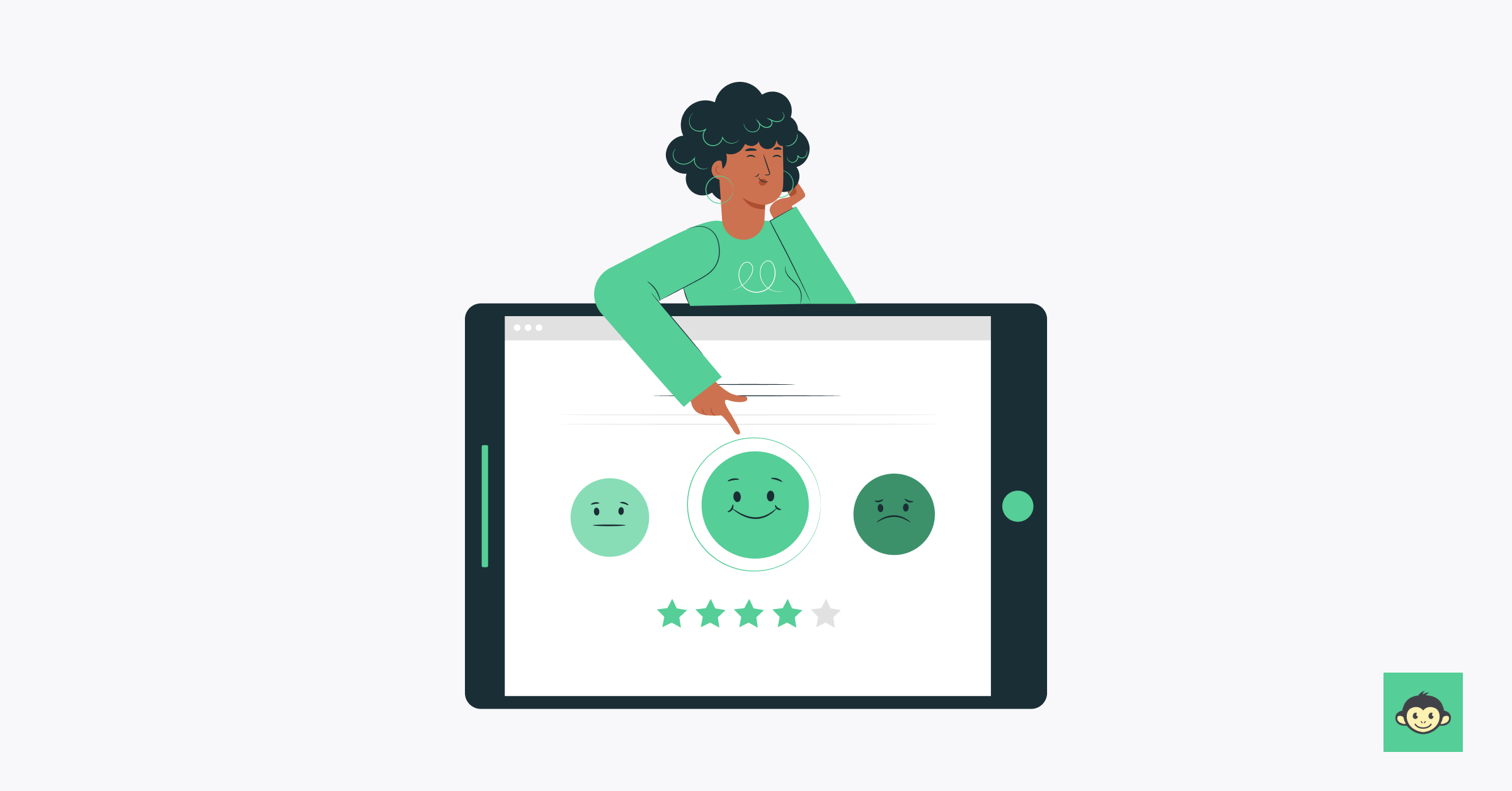
Are you tired of those annual employee surveys that feel as exciting as waiting for your toast to pop up in the morning? Well, get ready to have your mind blown because today, we're diving into the fascinating world of measuring employee satisfaction using pulse feedback powered by AI!
Picture this: you walk into the office on a Monday morning, eager to catch up with your colleagues after a relaxing weekend. As you settle in, you notice Steve from Accounting wearing a permanent scowl, and Emma from Marketing seems to have lost her usual pep in her step.
Your instinct tells you something's off, but how can you gauge the pulse of the office without becoming a human lie detector?
Enter AI, the superhero of modern workplace analytics. With its incredible ability to process vast amounts of data, AI can swiftly analyze pulse feedback to measure and gauge employee satisfaction in real-time. It's like having a secret mood radar for your entire organization!
Now that we've piqued your interest, let's dive deeper into AI's incredible role in measuring employee satisfaction using pulse feedback.
Table of contents:
- Why analyzing pulse feedback is important?
- What is the role of artificial intelligence in employee engagement and retention?
- Role of AI in feedback sentiment analysis
- How can AI help in spotting negative pulse feedback?
- How can AI help in measuring pulse survey metrics?
- How can you leverage AI to take quicker actions on pulse feedback?
- What is the effect of artificial intelligence on employee performance?
- Conclusion
Why analyzing pulse feedback is important?
So, you might be wondering, why bother with pulse feedback and analyzing it in the first place? Well, let us enlighten you! Pulse feedback is like a window into the hearts and minds of your employees. It provides valuable insights into their experiences, emotions, and overall satisfaction levels.
Gone are the days of relying solely on annual surveys that feel like a one-time snapshot of the workplace. With pulse feedback, you get a continuous stream of data, allowing you to capture real-time feedback and address any concerns promptly. It's like having your finger on the pulse of your organization's well-being.
Remember Steve and Emma? Let's see how pulse feedback could have come to the rescue. With AI-powered analysis of pulse feedback, HR could have detected a common thread of dissatisfaction among employees.
Maybe the company's new performance evaluation system was causing frustration and affecting morale. Armed with this information, management could have swiftly intervened, communicated changes, and provided the necessary support to alleviate the discontent.
As a result, Steve and Emma, along with their colleagues, would have felt heard, valued, and motivated to give their best.
Furthermore, analyzing pulse feedback allows you to identify patterns, trends, and areas for improvement across the organization. It helps you spot potential issues before they snowball into major problems. Proactively addressing concerns and making data-driven decisions can foster a positive work culture and boost overall employee happiness and satisfaction.
In a nutshell, analyzing pulse feedback is like having a superpower that enables employees to create a more engaged workforce.
What is the role of artificial intelligence in employee engagement and retention?
Ah, the dynamic duo of pulse surveys and artificial intelligence – an unstoppable force when it comes to increasing employee engagement and retention!
Pulse surveys, as we've previously explored, provide valuable insights into employees' job satisfaction, concerns, and engagement levels. But when you combine them with the prowess of AI, magic happens. AI algorithms can analyze pulse survey data, identify trends, and generate actionable insights to enhance employee engagement and retention.
For example, consider a company that conducts regular pulse surveys and leverages AI to analyze the results. AI detects a recurring theme of employees expressing a desire for more growth opportunities. By proactively addressing employee aspirations, the company demonstrates its commitment to growth and fosters a sense of loyalty and engagement among its workforce.
In essence, pulse surveys powered by AI provide a feedback loop that allows organizations to understand their employees' needs, make data-driven decisions, and take swift action to foster engagement and retention.
It's like having a compass that guides companies in creating an environment where employees thrive, grow, and build long-lasting careers.
Role of AI in feedback sentiment analysis
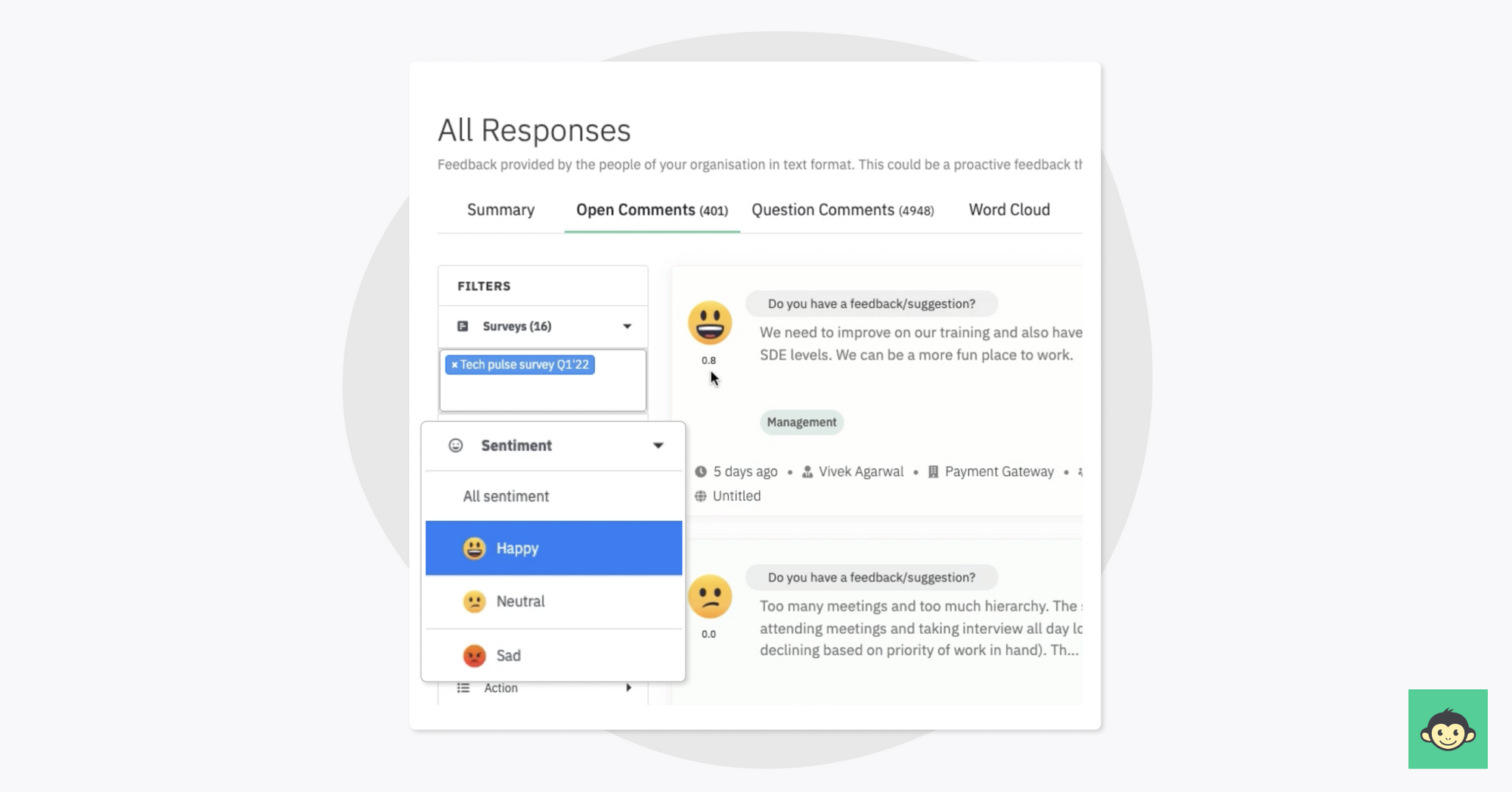
Now, let's dive into the incredible role of AI in feedback sentiment analysis. Imagine this: you receive a flood of pulse feedback responses from your employees, all filled with different emotions and opinions. How do you make sense of it all? Well, enter AI!
Using sophisticated natural language processing algorithms, AI can analyze the collective employee responses and determine whether the feedback is positive or negative.
But here's the fun part – it doesn't stop there! AI takes it a step further by translating those sentiments into appropriate emojis, making it easier than ever to understand the overall vibe in your workplace.
Just picture it: a dashboard filled with smiley faces, thumbs-up, and fireworks for positive feedback and frowning faces, thumbs-down, and thunderclouds for negative feedback. It's like having your very own emoji translator for employee sentiments!
By leveraging AI's power, you can quickly identify trends, hotspots, and areas for improvement. Are there specific departments that consistently receive positive feedback? Fantastic! Celebrate their success and learn from their strategies.
On the flip side, if certain teams consistently receive negative feedback, it's time to step in, investigate the underlying issues, and take corrective action.
So, say goodbye to the days of sifting through lengthy paragraphs and struggling to gauge the overall sentiment. With AI's help, feedback sentiment analysis becomes a breeze, allowing you to understand the collective mood of your workforce at a glance.
How can AI help in spotting negative pulse feedback?
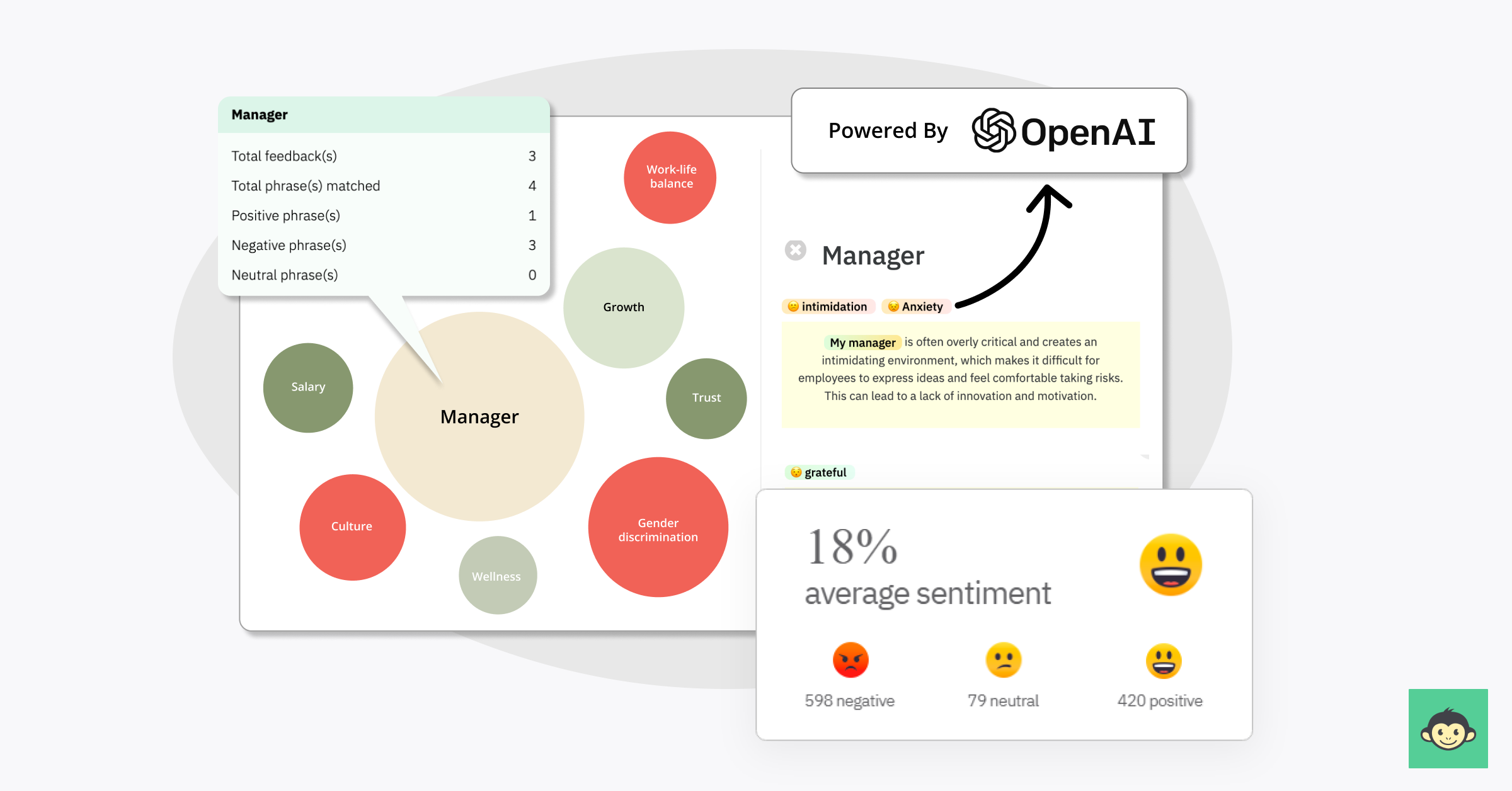
But wait, there's more! AI doesn't just stop at identifying whether the feedback is positive or negative; it goes the extra mile by helping you spot the crucial negative pulse feedback that requires immediate attention.
Imagine receiving thousands of pulse feedback responses, each containing unique insights and concerns. It might feel overwhelming to identify the most critical negative feedback, but fear not, for AI has your back!
Using advanced algorithms, AI can perform contextual analysis and create a bubble chart of the most common keywords found in the negative feedback.
This bubble chart acts as a visual representation of the pain points and issues faced by your employees. Larger bubbles indicate the most frequently mentioned keywords, making it easy for you to pinpoint the crucial negative feedback that requires immediate action. It's like having a magnifying glass that zooms in on the areas that need your attention the most.
By harnessing the power of AI's contextual analysis, you can proactively address the root causes of dissatisfaction and make targeted improvements.
Whether it's an issue with work-life balance, lack of career growth opportunities, or communication breakdowns, AI helps you uncover these insights and take appropriate measures to create a positive change in your organization.
How can AI help in measuring pulse survey metrics?
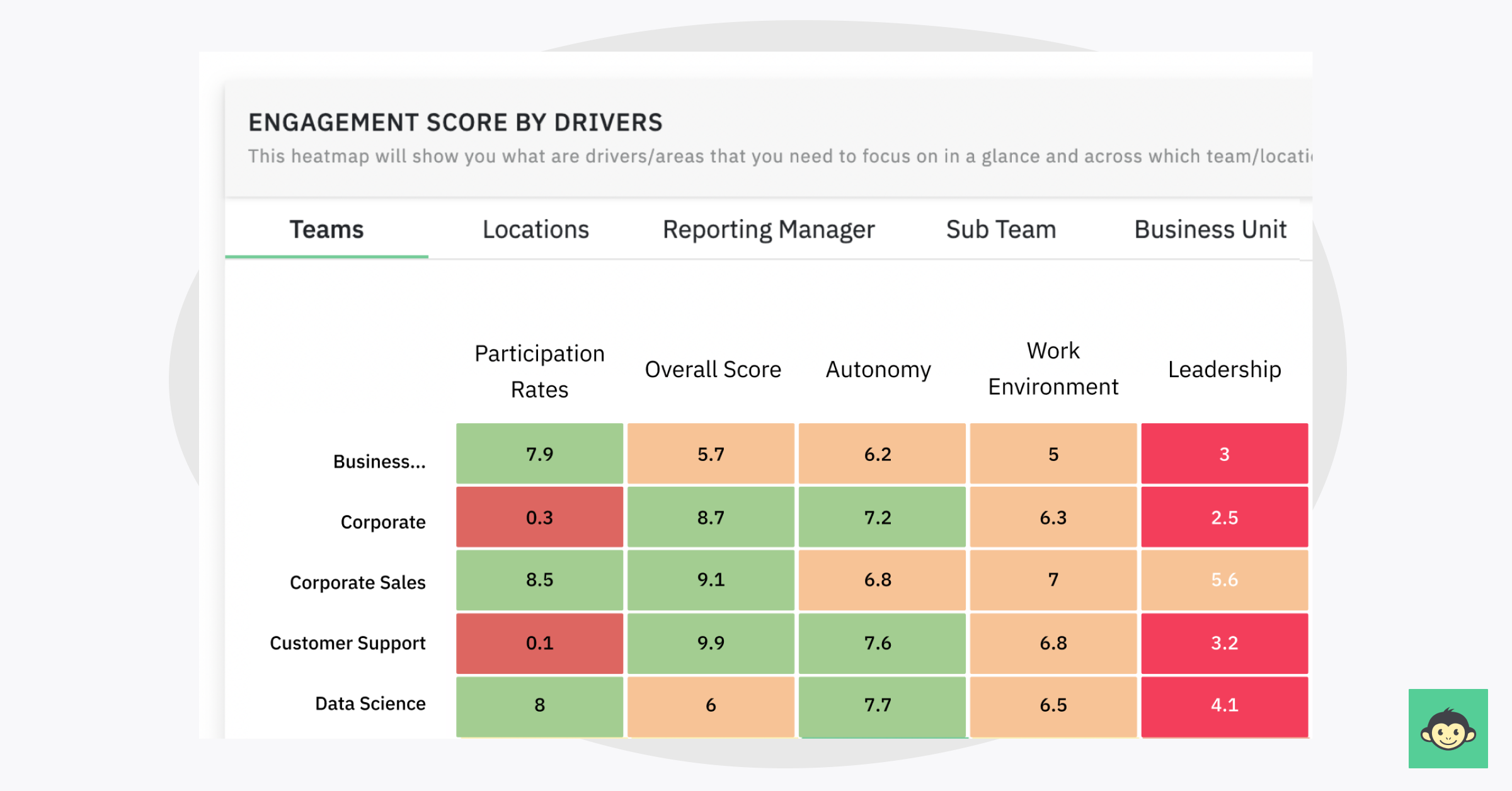
AI takes pulse survey analysis to a whole new level by providing insights into the key drivers of employee engagement across teams. How does it do this? By leveraging its analytical prowess to examine the patterns and correlations hidden within the data.
A vibrant heatmap showcases the various factors influencing employee engagement, such as communication, recognition, work-life balance, and professional development. Each team is represented by a different color, and the intensity of the color indicates the level of engagement.
This visually stunning representation allows you to quickly identify areas of strength and areas that need improvement within your organization.
Thanks to AI, you can gain a deeper understanding of what truly drives employee engagement, enabling you to make data-backed decisions and tailor your strategies accordingly.
By focusing on the specific areas that require attention, you can create targeted initiatives to enhance engagement and foster a thriving workplace culture.
How can you leverage AI to take quicker actions on pulse feedback?
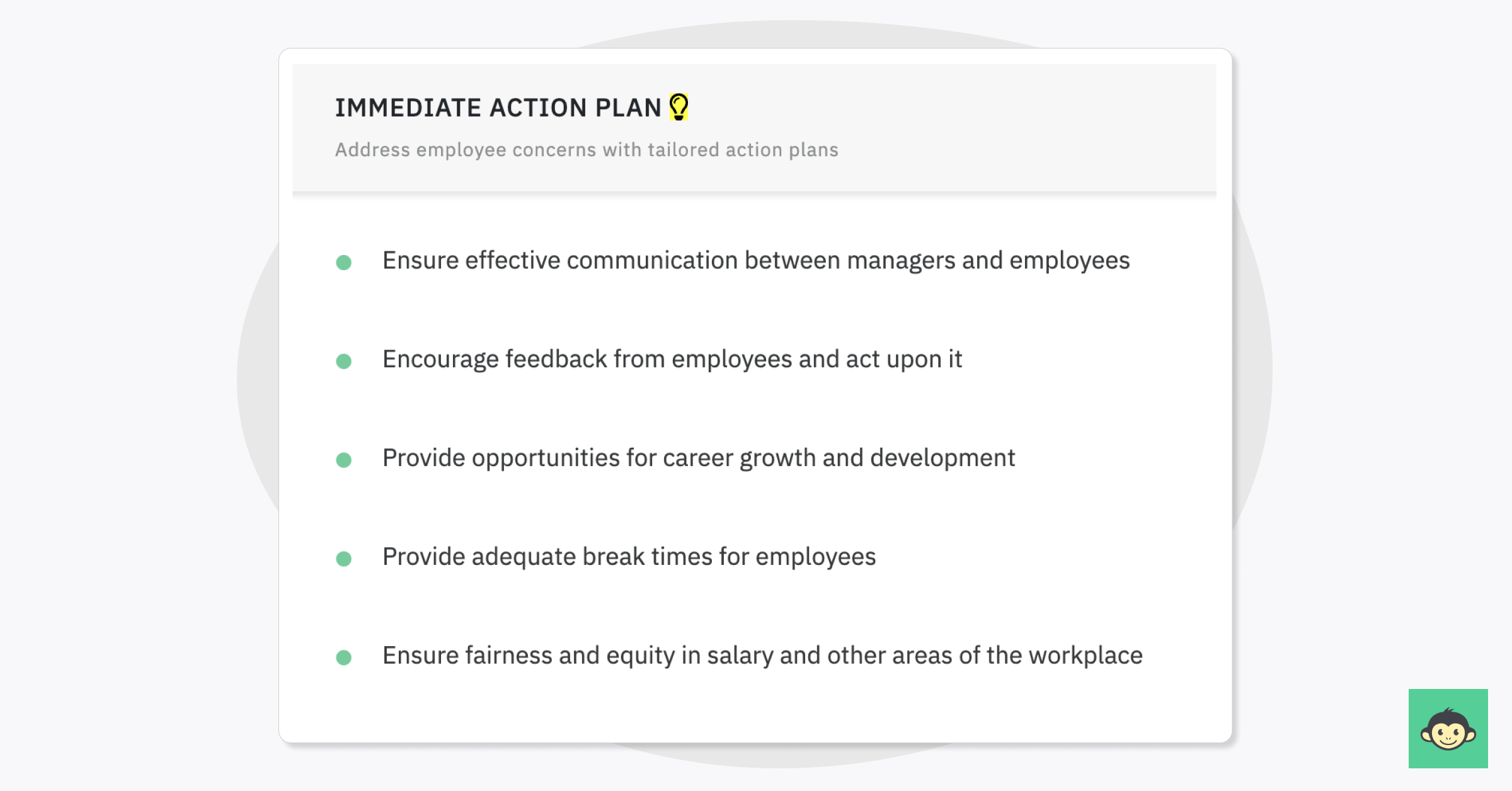
By processing and analyzing the pulse feedback data, AI can identify patterns, trends, and areas of improvement with lightning speed. It takes into account the context, sentiments, and engagement drivers we discussed earlier. But here's the exciting part – AI goes beyond analysis and offers concrete action recommendations.
Imagine receiving a comprehensive report that not only highlights the challenges your organization is facing but also provides a roadmap for improvement.
AI algorithms can sift through vast amounts of employee data, identify best practices, and suggest targeted actions to address specific pain points. It's like having a dedicated consultant right at your fingertips!
These AI-powered action recommendations enable companies to make informed and strategic decisions swiftly. They streamline the process of translating feedback into action, allowing organizations to proactively address employee concerns, improve employee satisfaction and boost overall engagement.
What is the effect of artificial intelligence on employee performance?
By utilizing AI-powered pulse surveys, companies can gain valuable insights into employee sentiments, engagement drivers, and areas of improvement. This wealth of information enables organizations to make data-driven decisions that directly impact employee performance.
How does it work, you ask? Well, AI can analyze employee pulse survey data to identify correlations between employee satisfaction, engagement, and performance metrics. It can uncover patterns that might not be apparent to the naked eye, providing a holistic view of the factors that contribute to high performance.
With AI's assistance, companies can identify the specific areas where improvements can be made to boost employee performance. It could be enhancing communication channels, implementing targeted training programs, or providing recognition and rewards that resonate with every engaged employee.
The result? Improved employee experience, performance, increased productivity, and a positive impact on the bottom line. When employees feel heard, supported, and engaged, they are more likely to go above and beyond in their roles, driving the overall success of the organization.
Conclusion
In conclusion, we've explored the fascinating role of AI in measuring employee satisfaction using pulse feedback. AI empowers organizations to analyze employee feedback sentiment, spot negative feedback, measure pulse survey metrics, and take quicker actions based on data-driven recommendations.
It revolutionizes employee performance, engagement, and retention, creating a dynamic and thriving workplace.
When it comes to leveraging AI for measuring employee engagement and satisfaction, there's one platform that stands out from the rest - CultureMonkey.
With its user-friendly interface, powerful AI algorithms, and comprehensive features, CultureMonkey is the go-to solution for organizations seeking to unlock the full potential of pulse feedback analysis.
Through CultureMonkey, you can effortlessly collect, analyze, and gain actionable insights from pulse feedback data. Its AI-driven employee sentiment analysis, heatmaps, and action recommendations provide a holistic view of employee satisfaction and enable you to make informed decisions swiftly.
Embrace the power of AI and choose CultureMonkey as your partner in measuring employee satisfaction through pulse feedback.
